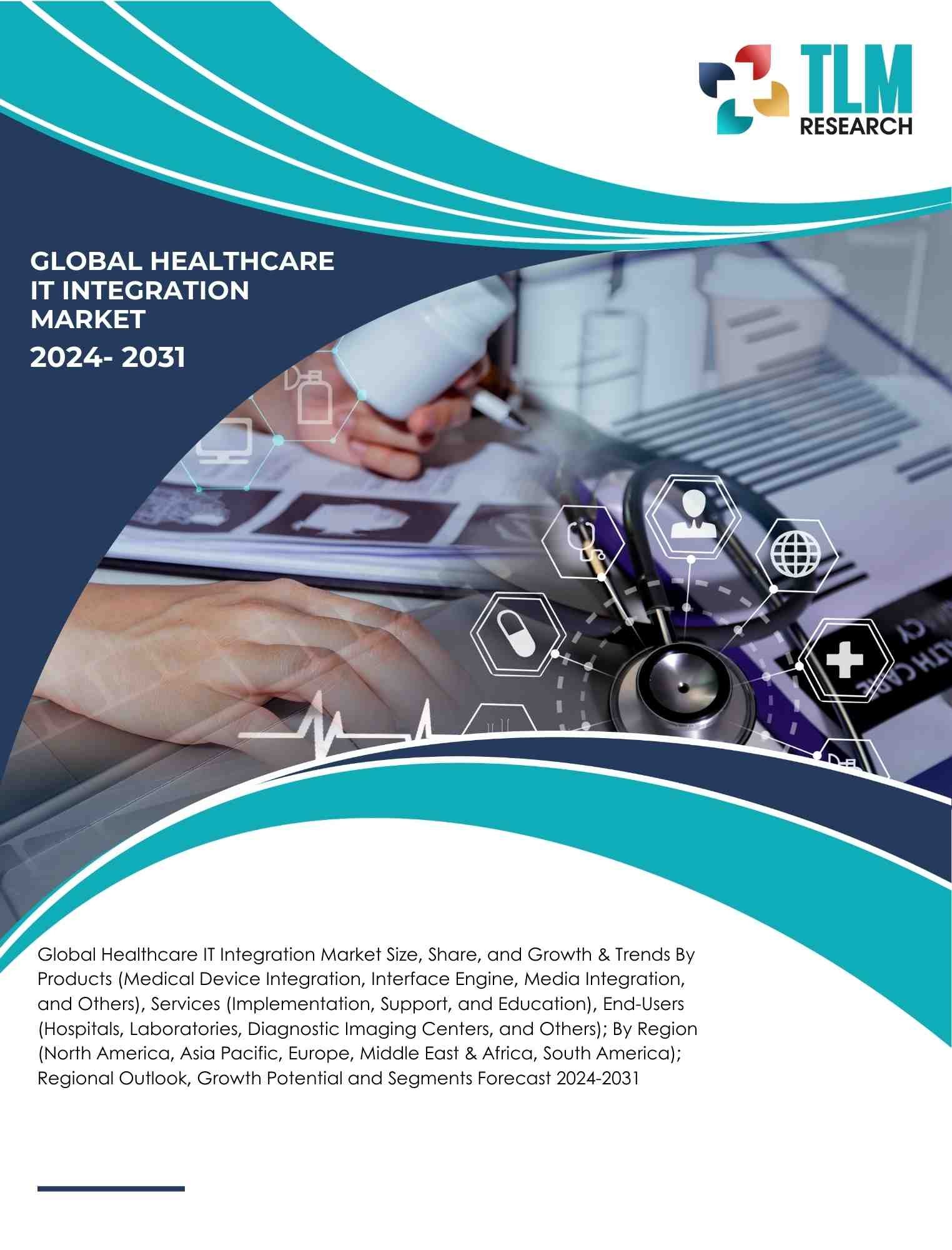Description
The Global Healthcare IT Integration Market size was USD $ 3.9 billion in 2023 and is projected to reach USD $ XX billion by 2031, with a CAGR of 12.4 % during the forecast period.
Global Healthcare IT Integration Market: Key Takeaways
Increased Adoption of Cloud-Based Solutions: Cloud-based healthcare IT integration is gaining traction due to scalability, cost-efficiency, and data accessibility. Healthcare providers are leveraging cloud solutions to store and analyze large volumes of patient data securely. This integration facilitates real-time collaboration across multiple locations, improves operational efficiency, and ensures seamless communication among healthcare professionals. As cloud technology continues to evolve, interoperability between cloud systems and existing IT infrastructure becomes more critical, enabling healthcare organizations to make data-driven decisions and enhance patient care delivery across a global scale.
Focus on Interoperability Standards: The Healthcare IT Integration Market is emphasizing interoperability to ensure that different systems and software can communicate and share data effectively. Initiatives such as HL7, FHIR, and DICOM standards are being widely adopted to maintain data consistency and improve clinical workflows. Regulatory mandates like the Office of the National Coordinator for Health IT (ONC) and GDPR also drive interoperability efforts. Strong interoperability allows healthcare providers to access, share, and analyze data seamlessly, which boosts patient outcomes, optimizes resource management, and ensures compliance with healthcare standards and regulations.
Growth in AI and Data Analytics Integration:: AI and advanced data analytics are becoming central to healthcare IT integration, offering insights that drive clinical decisions and operational efficiency. Predictive analytics, machine learning algorithms, and AI-driven diagnostic tools enhance decision-making processes, reduce errors, and optimize treatment planning. Data integration across various healthcare systems allows hospitals and clinics to forecast trends, manage patient loads more efficiently, and improve diagnostic accuracy. Such integration also aids in personalized medicine, where treatment plans are customized based on patient data and health history, ultimately improving healthcare outcomes.
Enhanced Security Measures and Compliance:: As healthcare IT integration grows, maintaining data privacy and security remains a top priority. Strong security measures, such as end-to-end encryption, multi-factor authentication, and robust firewalls, protect sensitive patient information. Compliance with regulations like HIPAA, GDPR, and cybersecurity frameworks is mandatory to avoid penalties and legal issues. Healthcare IT vendors are increasingly investing in cybersecurity technologies and implementing best practices to safeguard data integrity. Ensuring robust security not only boosts trust among patients and healthcare providers but also minimizes risks of data breaches and associated financial and reputational damages.
Global Healthcare IT Integration Market: Overview
The Global Healthcare IT Integration Market is experiencing significant growth driven by the increasing demand for streamlined healthcare operations, interoperability, and real-time data sharing across medical facilities. Connectivity solutions enable seamless communication between medical devices, IT systems, and healthcare infrastructure, enhancing workflow efficiency and improving patient care outcomes. The market is propelled by factors such as the growing adoption of electronic health records (EHRs), advancements in Internet of Things (IoT) technology, and the integration of Artificial Intelligence (AI) in clinical settings.
Furthermore, the need for compliance with stringent healthcare regulations and data protection standards is driving investments in secure connectivity solutions. The market is segmented into various devices, including patient monitoring devices, infusion pumps, imaging systems, and clinical diagnostic equipment, each playing a crucial role in healthcare connectivity. Hospitals, clinics, and diagnostic laboratories represent significant application areas, while cloud-based connectivity solutions are witnessing higher adoption due to scalability and cost efficiency. North America dominates the market due to robust healthcare infrastructure and technological advancements, whereas the Asia-Pacific region is witnessing rapid growth due to increasing healthcare investments and digitization efforts.
Despite challenges such as data privacy concerns and interoperability issues, the market offers substantial opportunities for innovation and integration of cutting-edge technologies. Overall, the Medical Device Connectivity market is set to expand as healthcare providers continue to prioritize interoperability, data integration, and operational efficiency, ultimately aiming to enhance patient outcomes and reduce healthcare costs.
Global Healthcare IT Integration Market: Growth Drivers
1. Increasing Demand for Integrated Healthcare Solutions
The demand for integrated healthcare IT solutions is driving the growth of the Healthcare IT Integration Market. Healthcare providers seek to improve operational efficiency, streamline workflows, and enhance patient care by integrating various IT systems, such as Electronic Health Records (EHR), Laboratory Information Systems (LIS), and Radiology Information Systems (RIS). Integrated IT solutions enable seamless communication across departments, allowing for real-time data sharing and improved clinical decision-making. This interconnected ecosystem helps reduce errors, enhance collaboration among healthcare professionals, and improve patient outcomes, thus promoting the widespread adoption of healthcare IT integration solutions across hospitals and clinics.
2. Government Initiatives and Regulations Promoting Digital Health
Government initiatives and policies aimed at promoting digital health infrastructure are significant growth drivers for the Healthcare IT Integration Market. Various governments worldwide are investing heavily in healthcare IT integration projects to comply with regulations that mandate interoperability, data sharing, and privacy protection. For instance, initiatives like the U.S. Healthcare Information Technology Standards Compliance encourage healthcare providers to adopt integrated IT solutions. Such initiatives aim to improve data accuracy, ensure transparency, and enhance accountability while addressing challenges like interoperability gaps. These policies create a conducive environment for investments in integration technologies and drive the overall growth of the healthcare IT integration market.
3. Advancements in Cloud Computing and AI Technologies
The integration of cloud computing and Artificial Intelligence (AI) technologies is a crucial growth driver in the Healthcare IT Integration Market. Cloud-based solutions offer scalability, cost efficiency, and accessibility, enabling healthcare organizations to store and share data securely across different locations. AI technologies, on the other hand, enhance data analysis, automate workflows, and improve diagnostic accuracy by integrating large datasets from various healthcare IT systems. As healthcare providers look for more cost-effective, scalable, and efficient ways to handle complex clinical and administrative operations, the demand for integrated IT solutions leveraging cloud and AI technology continues to grow.
Global Healthcare IT Integration Market: Restraining Factors
1. Data Security and Privacy Concerns
One of the major restraints in the Healthcare IT Integration Market is the challenge of maintaining data security and ensuring privacy. Healthcare data contains sensitive information, including personal health records, which must be adequately protected against cyberattacks and breaches. Compliance with data protection regulations, such as HIPAA (Health Insurance Portability and Accountability Act) and GDPR (General Data Protection Regulation), often requires substantial investments in cybersecurity infrastructure and expertise. Any lapse in data protection can result in legal penalties, financial losses, and damage to trust and reputation. Healthcare organizations often struggle with integrating disparate IT systems securely, which adds complexity and cost to the integration process.
Global Healthcare IT Integration Market: Opportunity Factors
1. Growing Adoption of Telehealth and Remote Patient Monitoring
The rising demand for telehealth services and remote patient monitoring presents substantial opportunities in the Healthcare IT Integration Market. Telehealth solutions require seamless integration of communication tools, EHR systems, and virtual consultation platforms to ensure effective remote interactions between patients and healthcare providers. Integrated healthcare IT systems facilitate real-time data sharing between remote devices and healthcare facilities, improving diagnostic accuracy and treatment planning. As telehealth continues to grow in popularity, especially in rural and underserved areas, healthcare IT integration becomes a crucial enabler for scalable and efficient remote healthcare delivery.
2. Increased Investments in Artificial Intelligence and Big Data Analytics
Healthcare organizations are increasingly investing in Artificial Intelligence (AI) and Big Data Analytics, which offer opportunities for Healthcare IT integration. Integrated IT systems enable healthcare providers to analyze large datasets, identify trends, and gain insights that drive better clinical and administrative decision-making. Predictive analytics, powered by AI, helps anticipate patient needs, optimize resource allocation, and improve treatment outcomes. Integrating these technologies across healthcare platforms boosts operational efficiency, reduces errors, and enhances clinical decision-making, ensuring long-term market growth.
3. Expansion of Healthcare IT Integration in Developing Regions
The expansion of healthcare infrastructure and IT integration initiatives in developing regions presents a significant market opportunity. Governments and private investors in countries across Asia-Pacific, Latin America, and the Middle East are increasingly prioritizing investments in digital health infrastructure to improve healthcare delivery.
Initiatives focused on integrating EHRs, LIS, and RIS are being implemented to enhance healthcare accessibility and efficiency. These initiatives drive demand for healthcare IT integration solutions, creating opportunities for technology providers to offer scalable and customized integration systems tailored to the specific needs of healthcare facilities in these regions.
Global Healthcare IT Integration Market: Challenges
1. Interoperability Issues Across Disparate Systems
A significant challenge in the Healthcare IT Integration Market is the difficulty in achieving interoperability across different healthcare IT systems. Healthcare organizations often use a mix of legacy and modern IT solutions, which are not always compatible with each other. Disparate systems, such as EHR, RIS, and LIS, often lack standardized data formats and communication protocols, leading to integration challenges.
These interoperability issues hinder real-time data sharing, result in inefficiencies, and compromise the quality of patient care. Resolving these challenges requires significant investments in integration technology, adherence to interoperability standards, and collaboration among healthcare IT vendors and stakeholders to create cohesive and adaptable solutions.
Global Healthcare IT Integration Market: Segment Insights
1. By Products:
The healthcare IT integration market is segmented into four main product categories: Medical Device Integration, Interface Engine, Media Integration, and Others. Medical Device Integration involves integrating medical devices such as monitors, imaging systems, and lab equipment into hospital IT networks to streamline operations. The Interface Engine segment connects healthcare systems with interfaces, facilitating data exchange across disparate systems, while Media Integration addresses the integration of media files, images, and documents in healthcare workflows.
Other products include tools that enhance interoperability and optimize healthcare IT infrastructure. A rise in demand for seamless data sharing, advanced diagnostic tools, and real-time monitoring across healthcare facilities is propelling these integration solutions. Innovations in cloud-based infrastructure, machine learning, and AI-driven analytics are anticipated to drive growth in these integration products, ensuring better interoperability, operational efficiency, and improved clinical outcomes across healthcare settings.
2. By Services:
The healthcare IT integration market includes services such as Implementation, Support, and Education. The Implementation service segment focuses on deploying integration solutions tailored to hospitals, diagnostic centers, and healthcare facilities, ensuring optimal performance. The Support service segment maintains system efficiency, minimizes downtime, and ensures ongoing software updates and troubleshooting. Lastly, Education services focus on training healthcare professionals and IT staff to effectively use integration systems, ensuring compliance and operational efficiency.
Increasing investments in IT infrastructure upgrades and a growing emphasis on interoperability and system integration across healthcare facilities are driving demand for these services. Additionally, service providers offer customized solutions that include real-time analytics, cloud integration, and machine learning tools, ensuring scalability, compliance, and streamlined operations across healthcare environments globally.
3. By End User:
The market is segmented into Hospitals, Laboratories, Diagnostic Imaging Centers, and Others. Hospitals remain the largest end-users of healthcare IT integration solutions due to a need for interoperability across large networks of devices and IT systems. Laboratories adopt integration technologies to enhance data management, workflow automation, and precision diagnostics. Diagnostic Imaging Centers leverage integration systems to connect imaging machines, streamline reporting, and facilitate quick data sharing.
Other end-users include rehabilitation centers and clinics. The integration of data across these facilities improves communication, reduces errors, and boosts operational efficiency. Furthermore, the increasing digitization of healthcare, demand for real-time reporting, and integration of AI and machine learning technologies are driving investments across these segments. Governments and healthcare organizations worldwide are prioritizing interoperability initiatives, further boosting the adoption of integrated IT solutions across healthcare facilities globally.
4. By Region:
The regional landscape for the healthcare IT integration market includes North America, Asia Pacific, Europe, Middle East & Africa, and South America. In North America, extensive healthcare digitization, stringent interoperability regulations, and technological investments drive market demand. Asia-Pacific is experiencing growth due to increasing investments in healthcare infrastructure, rising healthcare digitization initiatives, and the growing importance of remote healthcare solutions. Europe emphasizes interoperability standards and data sharing compliance, bolstered by initiatives such as EU health integration frameworks.
The Middle East & Africa region is witnessing investments in modernization and digital health initiatives, driven by technological upgrades and healthcare infrastructure development. In South America, market growth is fueled by initiatives to improve hospital IT infrastructure and digitize healthcare workflows, alongside increasing investments in healthcare technologies to enhance diagnostic efficiency and operational integration. Across all regions, strategic government policies, technological advancements, and collaborations between IT companies and healthcare providers ensure robust market expansion and improved healthcare outcomes.
Global Healthcare IT Integration Market: Segmentation
- Based on Product: The market is segmented Medical Device Integration, Interface Engine, Media Integration, and Others.
- Based on Services: The market is segmented Implementation, Support, and Education.
- Based on End User: The market is segmented Hospitals, Laboratories, Diagnostic Imaging Centers, and Others).
Global Healthcare IT Integration Market: Recent Developments
In June 2023, BoomerangFX, a cloud-based SaaS provider specializing in comprehensive practice management solutions for healthcare sectors such as cosmetic dentistry, cosmetic surgery, dermatology, medical spa, vision care, and women’s health, unveiled a strategic collaboration with health technology pioneer DrFirst. The aim of this partnership is to introduce an innovative e-prescribing solution tailored for aesthetic medicine practices throughout North America.
In May 2023, athenahealth made a significant announcement regarding its ‘athenaOne’ integrated cloud-based EHR, medical billing, and patient engagement solution. This solution, along with ‘athenaOne Dental,’ was chosen by LCH Health and Community Services to enhance provider and patient experiences while advancing its growth strategy.
In April 2023, Epic and Microsoft partnered to leverage generative AI for enhanced EHRs. This partnership involves integrating the Microsoft Azure OpenAI Service into Epic’s EHR platform, enhancing functionalities like interactive data analysis, and natural language queries, extending to Epic’s SlicerDicer, a self-service reporting tool.
Key Market Players:
- Philips Healthcare
- McKesson Corporation
- eMDs, Inc.
- Veradigm Inc. (formerly Allscripts Healthcare Solutions, Inc.)
- Athenahealth, Inc. (Acquired by Hellman & Friedman and Bain Capital)
- Carestream Health
- GE Healthcare
- Agfa- Gevaert Group
- Hewlett Packard Enterprise Development LP
- Novarad, Optum, Inc.
- IBM
- Oracle
- SAS Institute, Inc.
- IQVIA, Verisk Analytics
- Inc., SAP, Accenture





